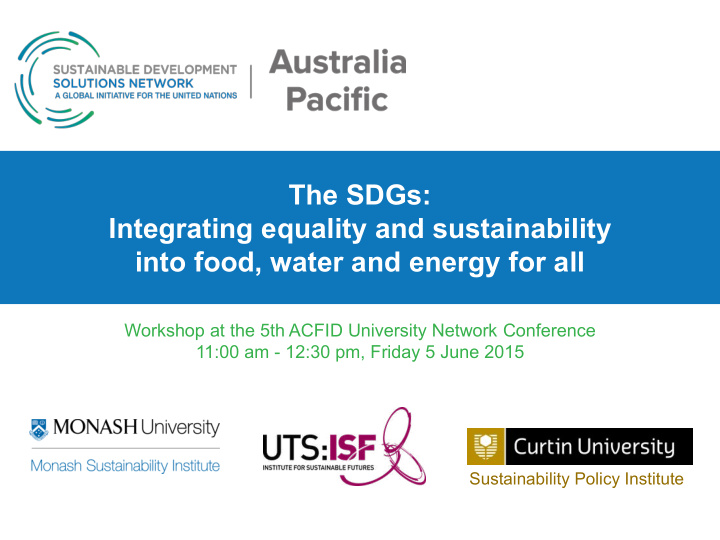



The SDGs: Integrating equality and sustainability into food, water and energy for all Workshop at the 5th ACFID University Network Conference 11:00 am - 12:30 pm, Friday 5 June 2015 Sustainability Policy Institute
Environment and development must be integrated • A prerequisite for future human development, including poverty reduction, is the stable functioning of Earth’s life support system • Since 2000, accumulating research shows that this functioning is at risk and that further human pressure may lead to large-scale, abrupt, and potentially irreversible changes • The new universal SDGS to be approved in September provide a framework for integration 2
Human wellbeing and ecosystem services Developing a single, sustainable development agenda is critical. ... Without environmental sustainability, we cannot end poverty; the poor are too deeply affected by natural disasters and too dependent on deteriorating oceans, forests and soils. … Right now, development, sustainable development and climate change are often seen as separate. (United Nations, 2013). United Nations. (2013). A New Global Partnership: Eradicate Poverty and Transform Economies through Sustainable Development . New York. 3
A framework for integrating environment and development 4
Integrating environment and development for SUSTAINABLE DEVELOPMENT • Poor and vulnerable groups are disproportionally dependent on ecosystem services for their livelihoods, and are most affected by Environmental and Natural Resource degradation and ecological shocks. • A “GDP of the poor” in India showing the contribution of ecosystem services shows its 6 times greater importance to their livelihoods • There are positive and negative potential Poverty-Environment linkages 5
Inequality –Global dynamics in the doughnut • Oxfam highlighted: “Social and planetary boundaries are interdependent. • Would eradicating poverty stress planetary boundaries: NO • Providing the additional calories needed by the 13% facing hunger would require 1% of global food supply • Energy for 19% lacking electricity would cause <1% increase in global CO2 emissions • IN CONTRAST • 50% of global carbon emissions are from 11% of the population • 33% of world’s sustainable nitrogen budget is used for meat production in the EU with 7% of world’s population. 6
Inequality –gender perspectives • Women’s leadership in environmental and natural resource management is well recognised (United Nations Development Programme 2009) • Women farmers typically achieve yields 20-30% lower than men. Most studies suggest women would achieve the same yields if they had equal access to productive resources and services • As in figure 2.2 countries with less gender inequality achieve higher average cereal yields than those with greater inequality. 7
Inequality –gender perspectives 8
Tools for integrating environment and development for SUSTAINABLE DEVELOPMENT • Finding Co-Benefits for food climate and people 9
Tools for integrating environment and development for SUSTAINABLE DEVELOPMENT • . 10
The Water Energy Food Nexus • An emerging global sustainability discourse • Framed as a complex trade-off relationship between water, energy and food ‘security’ (Middleton et al. 2015) • Contested boundaries (e.g. water, food, energy, carbon, climate, environment, justice, etc: Wallis 2015) • Recognises interdependence and potential for synergies through cooperation across all sectors (Rasul and Sharma 2015). Middleton, C.; Allouche, J.; Gyawali, D., Allen, S. (2015) The rise and implications of the water-energy-food nexus in Southeast Asia through an environmental justice lens. Water Alternatives 8(1): 627-654 Rasul, G., & Sharma, B. (2015). The nexus approach to water-energy-food security: an option for adaptation to climate change. Climate Policy . Wallis, P. (2015). A nexus of nexuses: systemic governance for climate response. In: Pittock, Hussey and Dovers (eds.) Climate, Energy and Water . pp. 253-267. 11 Cambridge: Cambridge University Press.
Energy supply example • A Climate Resilient Mekong Project: Alternatives to the Lower Se San 2 Dam, Cambodia – From the Nexus Dialogue toolbox http://tools.waternexussolutions.org/ • Construction of one large hydroelectric dam would be unable to pass sediment required for downstream ecological functioning and sustainability of fisheries • Alternative proposal for four smaller dams would increase sediment flows and generate the same amount of energy Annandale, G. (2013) A Climate Resilient Mekong Project: Technical Memorandum on Options for Sediment Passage through Lower Se San 2 Dam 12
Major inequality of access (globally Water and this example, in Vietnam) Today, about 700 million people live in countries experiencing water WRM stress or scarcity. By 2035, it is projected that 3 billion people will be living in conditions of severe WASH water stress. (World Bank) services over-use Open defecation free, but Human contamination rights health and environmental climate change benefits left unachieved water availability scarcity multiple water uses domestic water use The Philippine Sanitation 13 Alliance (USAID 2008)
Questions for groups focused on: 1. Food, 2. Water and 3. Energy 1. In what specific ways are inequalities (in access to food, water and energy) exacerbated by broader lack of attention to sustainable management of natural resources? Based on these, what new areas of practice and advocacy should be addressed? 2. How can an integrating approach (as per the proposed SDGs) encourage synergies rather than trade-offs between the equitable provision of food, water or energy AND environmental sustainability. NOTE we will circulate around 2 groups world café style 14
Recommend
More recommend